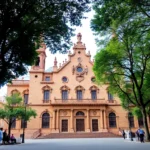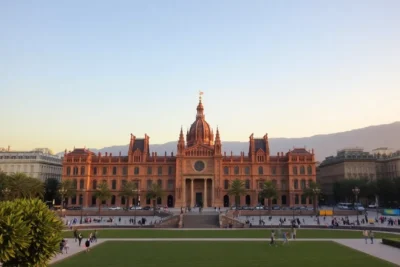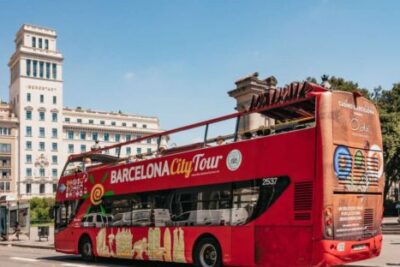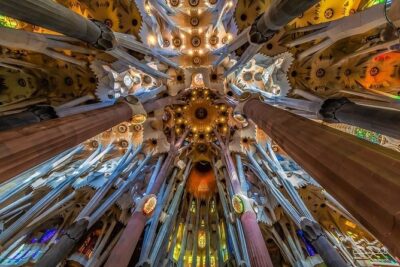
Barcelona is a city rich in history, with its roots extending deep into ancient times. From its humble beginnings as a small settlement to its rise as a major cultural and economic hub, the story of Barcelona is a fascinating journey through time. In this article, we will explore the various epochs that have shaped this vibrant city, shedding light on its significant milestones and transformations.
Foundation: The Roman Era
The history of Barcelona dates back to the earliest human settlements in the region, which can be traced as far back as 2500 BC. Archaeological evidence suggests that a first settlement existed between 2000 and 1500 BC. By the 4th century BC, the area was home to two Iberian settlements, as noted by the Latin poet Rufus Festus Avienus. One was located on the hill of Taber, whose name remains uncertain, but historians have referred to it as Barcilo, Barcinom, or Barkeno, which likely inspired the name Barcelona. The second settlement was on the current site of Montjüic, known as Laye, which was inhabited by the Layetani Iberians.
Many are curious to learn when was Barcelona founded. In 218 BC, the Romans arrived and established a fortress on Montjüic. Under Augustus, the population shifted from the fortress to the hill of Taber, which is now the site of Plaza Sant Jaume, marking the true origin of Barcelona. The Romans named the city Colonia Iulia Augusta Faventia Paterna Barcino.
During the 3rd century, Barcino suffered destruction at the hands of Frankish hordes. Once rebuilt, it was fortified with an impressive wall encompassing over 100,000 square meters, a testament to the city’s growing significance at the time. In 415 AD, Ataulfo, king of the Visigoths, seized Barcino and briefly made it his court before moving to Toulouse after his assassination.
The city remained under Visigothic control for three centuries until it fell into Muslim hands around 717-718. The Muslim presence lasted approximately a century.
In 758, the Muslim valí sought independence from the Umayyad Emirate of Córdoba and requested assistance from the Franks. This aid soon turned into an annexation, leading to forty years of power struggles before Barcelona was fully integrated into Frankish territories.
The County of Barcelona
In 801, following the liberation of the city from Muslim rule by Ludovico Pio, son and vassal of Charlemagne, the Franks established the County of Barcelona, integrating it into the Marca Hispánica within the Carolingian Empire.
The County was a small region bordered by the Counties of Girona and Osona. In 803, the Franks appointed the first Count of Barcelona, a Gothic noble named Bera. For a century, the County was governed directly by Frankish counts, facing several incursions from Islamic forces in 827, 850, 852, and 856.
In 878, Louis the Stammerer named Wifredo Count of Barcelona, Gerona, and Urgell, allowing the County to gain preeminence over other Catalan counties. Under Count Sunyer, the influence expanded to the Ebro delta, despite the ongoing threats from Muslim raids, including the devastating attacks of 965 and the catastrophic one led by Almanzor in 985.
Taking advantage of the weak leadership after the death of the last Carolingian emperor, Borrell II, Count of Barcelona, Gerona, Osona, and Urgell, declared independence from the French monarchs by refusing to pay homage to the new Frankish king, Hugh Capet, citing a lack of support against Almanzor's incursions.
The continuous alliances and disputes with neighboring counties of Urgell, Osona, and Girona were shaped by a historical ebb and flow of inheritances and treaties.
It was under Ramón Berenguer I that the County of Barcelona matured, extending its power to Ribagorza and almost to Tarragona, while also collecting tributes from the neighboring Muslims. His successor, Ramón Berenguer II, aimed to conquer Valencia but faced opposition from El Cid.
Ramón Berenguer III married the heiress of the County of Provence, which led to a period of international expansion, including the temporary conquest of Mallorca in 1114. However, this union dissolved upon Ramón Berenguer III's death.
In 1137, Ramón Berenguer IV married Petronila, daughter of Ramiro II of Aragón, leading to the integration of the County of Barcelona into the Crown of Aragón.
Barcelona in the Crown of Aragón
The marriage with the kingdom of Aragón stimulated the expansion of the County of Barcelona throughout Catalonia, establishing Barcelona as the political and economic center of the new Crown of Aragón. The city frequently hosted the Cortes of the Crown of Aragón.
The vigorous expansion of the Crown of Aragón across the Mediterranean turned Barcelona into one of the most significant cities of the era. In 1249, King James I founded the municipality of Barcelona, stipulating governance by five Consellers and the Consell de Cent.
Prosperity continued until 1333 when famine and plague claimed thousands of lives, exacerbated by the Black Death four years later. This epidemic afflicted the city recurrently during the 15th and 16th centuries.
In 1401, Barcelona established its first public bank, the “Taula de Canvis.”
However, the 15th century brought economic decline. The soaring prices and wages led to a significant crisis, reducing trade with the East. The city was divided into two factions, the “Busca” and the “Biga,” which clashed over power responsibilities.
The devaluation of currency, the loss of foreign trade to Valencia, and the paralysis of the textile industry compounded the problems, culminating in the “war of the remences,” a peasant uprising against their lords, and conflict with John II of Castile, which devastated Barcelona.
By the end of the 15th century, the “privilege of insaculation” granted by Ferdinand II of Aragón to several cities, which involved distributing municipal power among local oligarchs by lottery, reduced tensions and marked the beginning of a slight recovery for the city.
From the Medieval World to Modernism
The marriage of Ferdinand II of Aragón and Isabella of Castile unified both kingdoms, causing the Crown of Aragón and Barcelona, as the de facto capital, to lose prominence to the more powerful Castile.
Barcelona developed a military naval industry and benefited from the precious metal trade between Seville and Genoa. In the early 17th century, the city began minting a pure copper coin and established the Banc de la Ciudat in 1609.
The 17th and 18th centuries were difficult for Barcelona. The loss of Mediterranean possessions, coupled with banditry fueled by oligarchic conflicts, devastated overland trade. The city also endured the Wars of Secession and Succession.
The War of Secession, or the Segadors' War, arose from the taxes imposed by the Spanish Crown to maintain a declining empire and fund the Thirty Years' War against France. The Catalans revolted against these new taxes, with support from Richelieu's France, leading to a conflict that ultimately favored the French, who gained half of Catalonia.
The War of Succession embroiled Europe in a struggle over the Spanish throne between supporters of the Bourbons and the Habsburgs. The Crown of Aragón and Barcelona sided with the Habsburgs, who promised to maintain local rights. However, the Austrians abandoned Catalonia, and after the Treaty of Utrecht, the region fell under Bourbon control.
The wars left Barcelona in ruins. When Spanish and French troops captured the city, they found it completely devastated. Following the city's support for the Habsburgs, the new king, Philip V, initiated a radical transformation of the existing status quo in Catalonia.
In 1716, Philip V enacted the Nueva Planta Decree, aimed at unifying his empire and abolishing local rights. Barcelona lost its insaculation regime, the Cortes, the Consell de Cent, the Generalitat, and its mint; the university was relocated to Cervera, and Castilian became the administrative language.
In the aftermath of the War of Succession, trade with the Americas and the rest of Spain rejuvenated Barcelona, leading to a flourishing textile industry that attracted thousands of workers to the city.
The growing working-class presence would soon trigger major social mobilizations. Notably, in 1854, workers initiated Spain's first general strike.
Barcelona entered a period of significant economic growth, urban transformation, and the tumultuous events of the 19th century.
In 1848, the first railway was inaugurated; in 1854, city walls were demolished; in 1859, the Ensanche was planned; in 1886, trams were electrified; and by the end of the century, grand avenues like Las Ramblas and numerous civic buildings were constructed.
Throughout this time, Barcelona endured the War of Independence, three Carlist Wars, the State of Siege in 1868, and numerous uprisings during the First Republic, marked by strikes, barricades, and confrontations. The arrival of the Restoration brought a temporary easing of social tensions, ushering in a golden age for the city in terms of economy, culture, and architecture.
In 1868, the Revolutionary Junta came to power and dismantled the fortress constructed by Philip V after the War of Succession in what is now the Parque de la Ciutadella, which would later host the first of Barcelona's two Universal Expositions in 1888.
Barcelona in the 20th Century: The Modernism Movement
At the turn of the 20th century, Barcelona emerged as a vibrant center for the modernist movement. Artists, designers, and architects left an indelible mark on the city, shaping its unique identity. Among its most celebrated figures was the brilliant Antoni Gaudí, the foremost representative of Catalan modernism.
In 1909, Barcelona experienced the “Tragic Week,” a significant worker uprising sparked by military conscription for the war in Morocco.
From 1909 onwards, the city entered a prosperous two-decade period. The demand for supplies by belligerent powers during World War I enriched the bourgeoisie of Barcelona. However, post-war, the city faced economic hardships characterized by intense conflicts between employers and the anarchist movement.
In 1923, Barcelona witnessed the coup d'état by General Primo de Rivera, which led to a period of economic prosperity and facilitated the organization of the city's second International Exposition in 1929.
With the proclamation of the Second Spanish Republic in 1931, Barcelona regained the Generalitat with the enactment of the 1932 Statute of Autonomy.
During the Civil War, Barcelona supported the Republican side, suffering bombings from Nationalist forces towards the war's end.
After the war, Barcelona benefited greatly from the regime, experiencing rapid industrialization and outstanding economic growth from 1960 to 1975.
With the fall of General Franco's dictatorship and the onset of democracy, Barcelona reclaimed its Generalitat and the status of the capital of Catalonia. Economic prosperity, largely fueled by Spain's entry into the European Union, allowed the city to host the 1992 Olympic Games.
The 1992 Olympics catapulted Barcelona onto the global stage, transforming it into one of the world’s top tourist destinations.
Today, Barcelona stands as a modern, open, and tolerant city, rightfully regarded as a cosmopolitan capital that offers everything one could dream of: a pleasant climate, beautiful beaches, a bustling port—Europe's largest cruise port—and a state-of-the-art airport, alongside remarkable monuments and a vibrant convention center.
 Swallows of Barcelona
Swallows of Barcelona More Photos
More Photos Discover the Majesty of Sagrada Familia: Barcelona's Iconic Gem
Discover the Majesty of Sagrada Familia: Barcelona's Iconic Gem Plaza Sant Jaume in Barcelona: A Historical Overview
Plaza Sant Jaume in Barcelona: A Historical Overview Contemporary Culture Center of Barcelona
Contemporary Culture Center of Barcelona Commuter Trains in Barcelona
Commuter Trains in BarcelonaIf you want to know other articles similar to History of Barcelona: A Comprehensive Overview you can visit the category Blog.
Deja una respuesta









Read more!